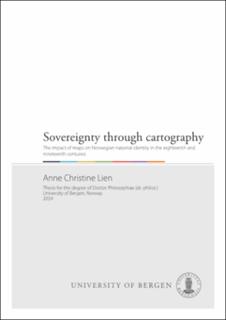Sovereignty through cartography : The impact of maps on Norwegian national identity in the eighteenth and nineteenth centuries
Doctoral thesis
Permanent lenke
https://hdl.handle.net/11250/3119114Utgivelsesdato
2024-03-08Metadata
Vis full innførselSamlinger
- Department of Geography [634]
Sammendrag
Kartografi har i mange hundre år blitt brukt som et politisk instrument for å støtte nasjonal stolthet og innflytelse. Det kan skje gjennom bruk av en nasjonal nullmeridian eller lokale stedsnavn, fremheving av landets areal ved hjelp av fargelegging av kart, eller understreking av landets posisjon og størrelse ved bruk av en velvalgt kartprojeksjon. Kart har dermed vært en av drivkreftene bak moderne territoriell suverenitet. I Skandinavia var 1600- til 1800-tallet en tid med store omveltninger, der flere regioner skiftet politisk tilhørighet frem og tilbake mellom nabolandene. Store arealer nord for polarsirkelen ble brukt som fellesområder av flere nasjoner, og grensen mellom Sverige og Norge ble først fastsatt i 1751. Det ble også langvarig politisk uro da Norge ble gitt som krigsbytte fra Danmark til Sverige i 1814.
Med dette som bakgrunn har jeg sett på hvordan kartografiske elementer kan ha innflytelse, samtidig som jeg har gjennomført en analyse av kart produsert av ulike kartografer, hovedsakelig skandinaviske. Hensikten har vært å undersøke hvilken rolle kartografi har spilt i Norges kamp for en nasjonal identitet innenfor rammen av to politiske unioner, først med Danmark, deretter med Sverige, og mot uavhengighet i 1905. Gjennom fire fagfellevurderte artikler har jeg utforsket ulike kartografiske elementer, blant annet nullmeridianer; nasjonale grenser; fargelegging av kart; og karttitler, dedikasjoner og stedsnavn.
Resultatene viser at ulike kartografiske fremstillinger av Skandinavia på 1700- til 1800-tallet reflekterte forskjellige syn på herredømme i regionen. Funnene viser at både Norge og Sverige brukte kart som verktøy for politisk påvirkning. Bruken av kartografiske elementer på de analyserte kartene antas å ha støttet territorielle krav, både på Nordkalotten, sentralt i Skandinavia, og krav på Norge som helhet i unionstiden. Temaet har fått ny aktualitet i dag når vi ser politisk bruk av kartografiske elementer i en pågående territoriell konflikt i Europa. Denne avhandlingen bidrar til kunnskap om kartenes påvirkningskraft, og om hvordan suverenitet kan hevdes ved hjelp av kartografi. Cartography has for centuries been used as a political instrument to support national pride, impact, and influence, whether through the use of a national prime meridian or local toponyms, by emphasising a country’s extent through colour, or by underlining and even distorting its position and size through projection. Maps are thus one of the driving factors behind the emergence of modern territorial sovereignty.
In Scandinavia, the seventeenth to nineteenth centuries were times of upheaval. Affiliations shifted back and forth in large parts of central Scandinavia, there was a vast region of common use at the Arctic frontier, the border between Sweden and Norway was not settled until 1751, and political turmoil arose when Norway was ceded as war booty from Denmark to Sweden in 1814. Against this backdrop, I have delved into the theory of cartographic elements and their potential influence, as well as conducting an empirical analysis of maps produced by different cartographers, mainly Scandinavian. The purpose has been to investigate the role of cartography in Norway’s struggle for national identity within the framework of two political unions, first with Denmark, then with Sweden, before finally achieving political independence in 1905. Through four peer-reviewed articles, I have explored different cartographic elements, namely prime meridians; national boundaries; map colouring; and map titles, dedications, and toponyms.
The empirical results indicate that various cartographic depictions of Scandinavia from the eighteenth to the nineteenth century reflect divergent perspectives on sovereignty. The findings seem to demonstrate that both Norway and Sweden used maps as instruments of political influence. Cartographic elements used on the maps analysed for this study are considered to support territorial claims not only in the Arctic region and central Scandinavia but also on Norway itself during the union period.
The topic has gained new relevance today when we see political use of cartographic elements in an ongoing territorial conflict in Europe. This thesis contributes to knowledge on the influence of maps, and on how sovereignty can be claimed through cartography.
Består av
Paper 1: Lien, A.C. (2019): From Fortress Flagpole to the Greenwich Line: The Establishment of a Common Prime meridian in Norway in the Period 1770-1970. Norsk Geografisk Tidsskrift – Norwegian Journal of Geography, 74(4): 262-279. The article is not available in BORA due to publisher restrictions. The published version is available at: https://doi.org/10.1080/00291951.2019.1682035Paper 2: Lien, A.C. and Lundberg, A. (2022): Lines of Power: The Eighteenth-Century Struggle over the Norwegian-Swedish Border in Central Scandinavia. The Cartographic Journal, 59(2): 102-119. The article is not available in BORA due to publisher restrictions. The published version is available at: https://doi.org/10.1080/00087041.2021.1995124
Paper 3: Lien, A.C. (2024): Colouring sovereignty: How Colour helped depict Territorial Claims to the Arctic in Northern Europe on Sixteenth to Nineteenth Century Maps. In: Lange, D., van der Linde, B. (eds.). Maps and Colours. A Complex Relationship, 82–101. The accepted version is available in the thesis file. The published version is available at: https://doi.org/10.1163/9789004467361_008
Paper 4: Lien, A.C. (2023): Waving the map for national identity: How cartography in Norway and Sweden was used as a nation-building tool in the eighteenth and nineteenth centuries. Erdkunde, 77(1): 13-34. The article is available at: https://hdl.handle.net/11250/3072863

